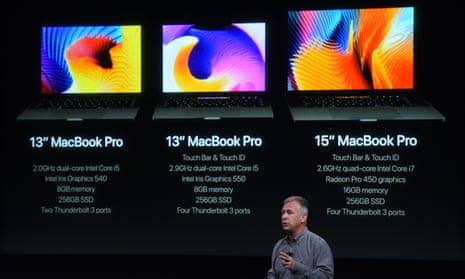If you’re a Mac user, everything just got a lot more expensive. Apple used the cover of introducing three new MacBook Pros at its latest event to quietly raise the prices of every single computer in its line.
It’s the latest example of the Brexit effect, with prices updated to account for the new low exchange rate between the US dollar and pound sterling. While the new laptops introduced on 27 October are significantly more expensive than the ones they are replacing, even machines that have seen no change at all have had their prices raised, in some cases by many hundreds of pounds.
The 13in MacBook Air, now the cheapest laptop in Apple’s range, starts at £949. A day earlier, it started at £849, while an even cheaper model, the now discontinued 11in MacBook Air, started at just £749.
The 12in MacBook, Apple’s smallest computer, starts at £1,249 for the very same model which sold for £1,049 24 hours ago. And the 13in and 15in MacBook Pros with Retina displays – the older model of MacBook Pro – are still on sale, starting at £1,249 and £1,899 respectively. On Thursday, those computers cost £999 and £1,599.
Similar price increases hit the company’s desktop computers. The Mac mini, still the lowest priced computer that Apple makes, has gone from £399 to £479. The cheapest iMac is now £1,049 up from £899, while the Mac Pro – a computer that hasn’t been updated for more than 1,000 days – has seen its base price increase by £500, from £2,499 to £2,999.
But while Apple has gained a reputation for overcharging British customers on currency conversions in the past, these prices are more than fair conversions of the dollar price for the same product – since the dollar prices are excluding sales taxes, while the pound prices are including VAT. A Mac mini in the US, for instance, costs $499 excluding tax, or £407 at current exchange rates. But a Mac mini in the UK costs £399 excluding tax, meaning Apple is making £8 less per computer sold in Britain than America. Overall, British customers still pay more, due to the much higher sales tax in Britain than America: 20%, compared to 0–13%.
In a statement, Apple said: “Apple suggests product prices internationally on the basis of several factors, including currency exchange rates, local import laws, business practices, taxes, and the cost of doing business. These factors vary from region to region and over time, such that international prices are not always comparable to US suggested retail prices.”

On top of the Brexit effect, however, all of Apple’s Mac customers worldwide are waking up to find out the company has significantly increased the average selling price of its laptop computers. It has discontinued the cheapest laptop it used to sell, the 11in MacBook Air, and introduced two extremely expensive laptops at the top end of its range: The 13in and 15in MacBook Pro with Touch Bar. Those computers start at $1,799 and $2,399 respectively, which equates to £1,749 and £2,349 in the UK.
Customers picking up those new computers can also expect to be hit with a barrage of further expenses, thanks to the controversial design decisions Apple made in the production process. The machines only include Thunderbolt 3 ports, a new standard which uses the USB-C connector.
That standard will rapidly become ubiquitous, but for now, very few accessories support it, requiring users to buy adapters if they are going to plug in devices such as monitors, external hard-drives, and iPhones. A Thunderbolt 3 to Thunderbolt 2 adapter costs £49/$49, a USB-C to Lightning cable costs £25/$25, and a USB-C to USB adapter costs £19/$19.
Apple is not alone in raising prices for British consumers following the referendum to leave the EU. Earlier this week, Microsoft announced an increase of up to 22% for business customers of its cloud products, blaming currency swings. And in the world of technology, where many products and services are priced directly in US dollars even for international customers, other companies didn’t even need to directly raise prices: Amazon Web Services, for instance, prices its services in dollars, even if users opt to be billed in Pound Sterling.





